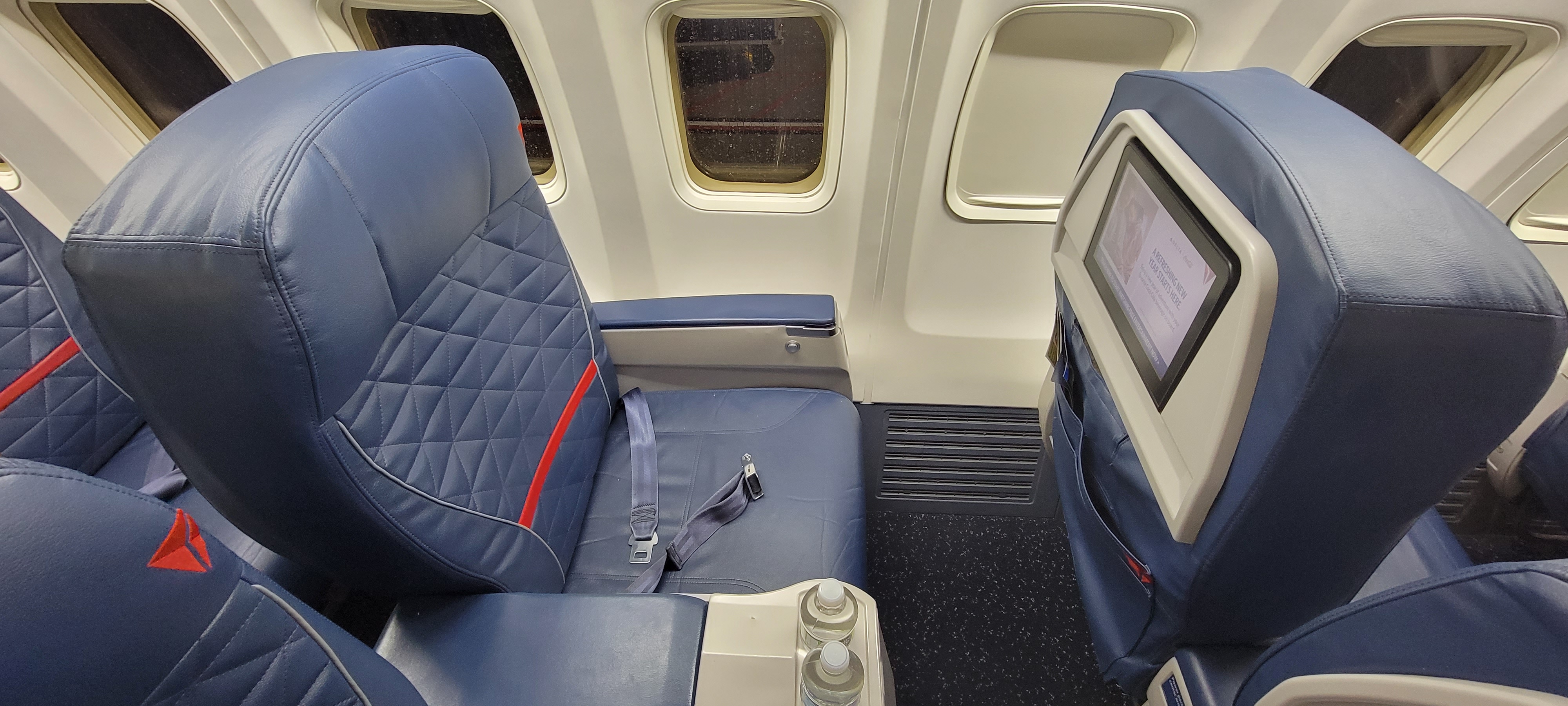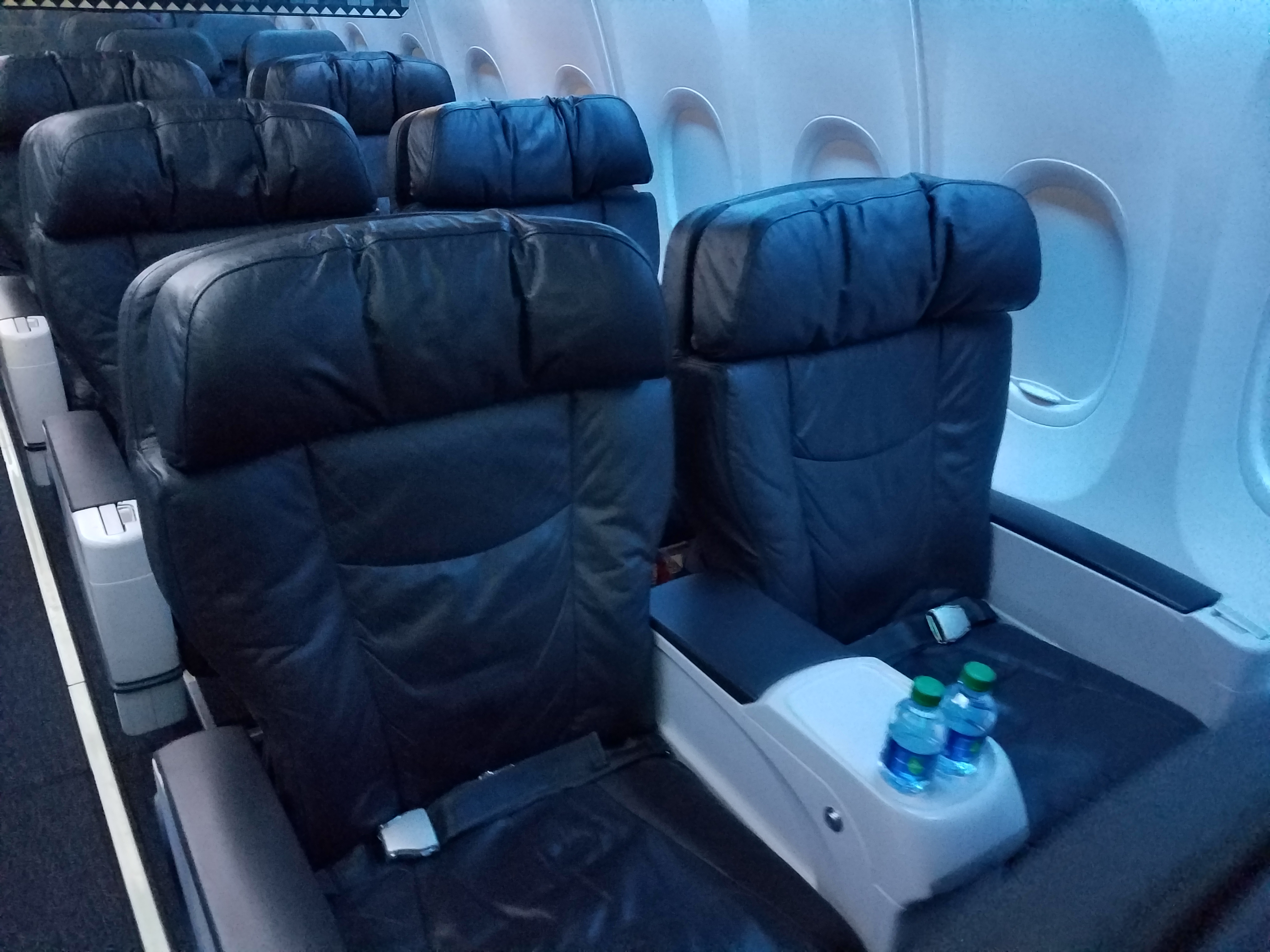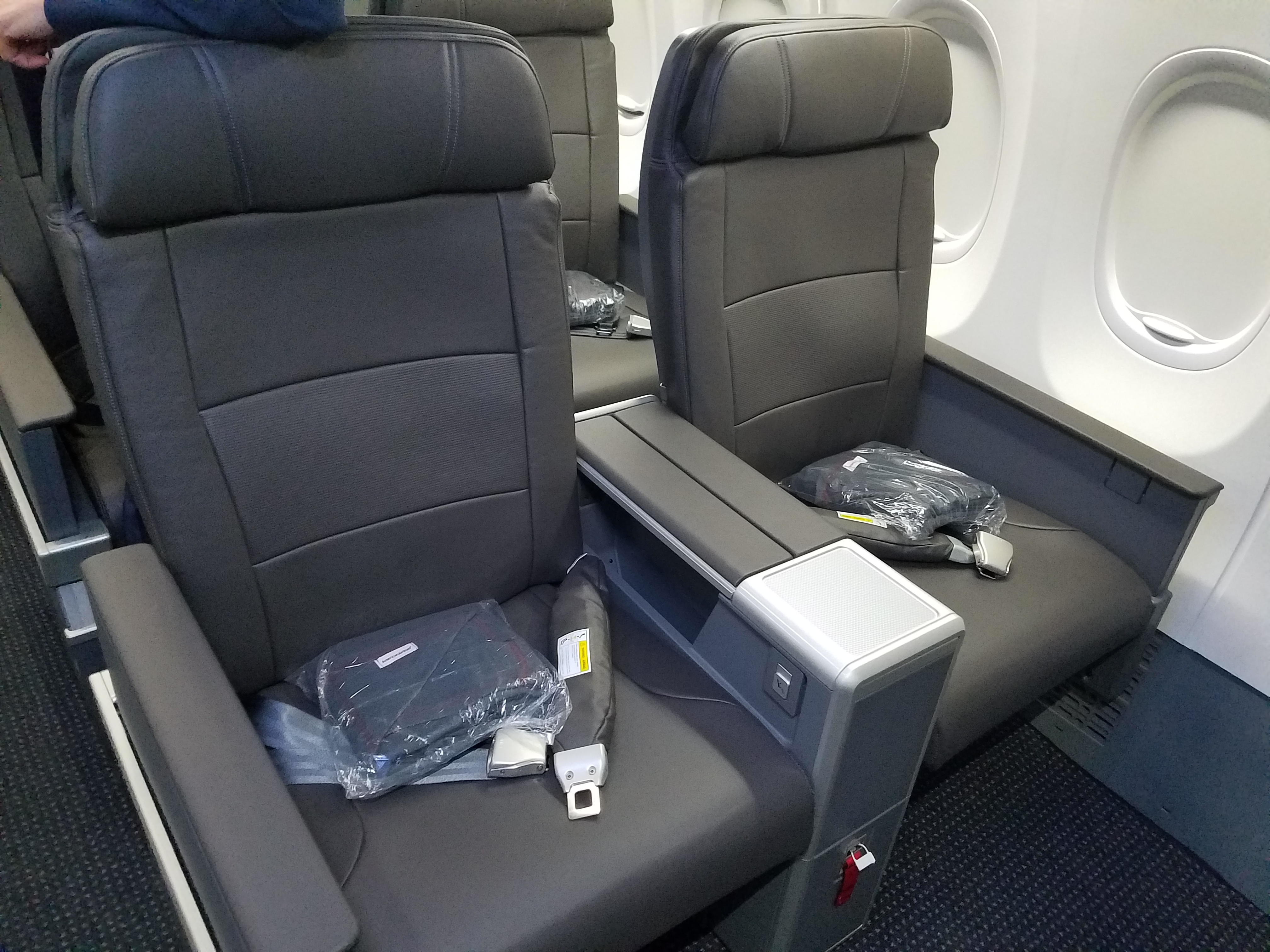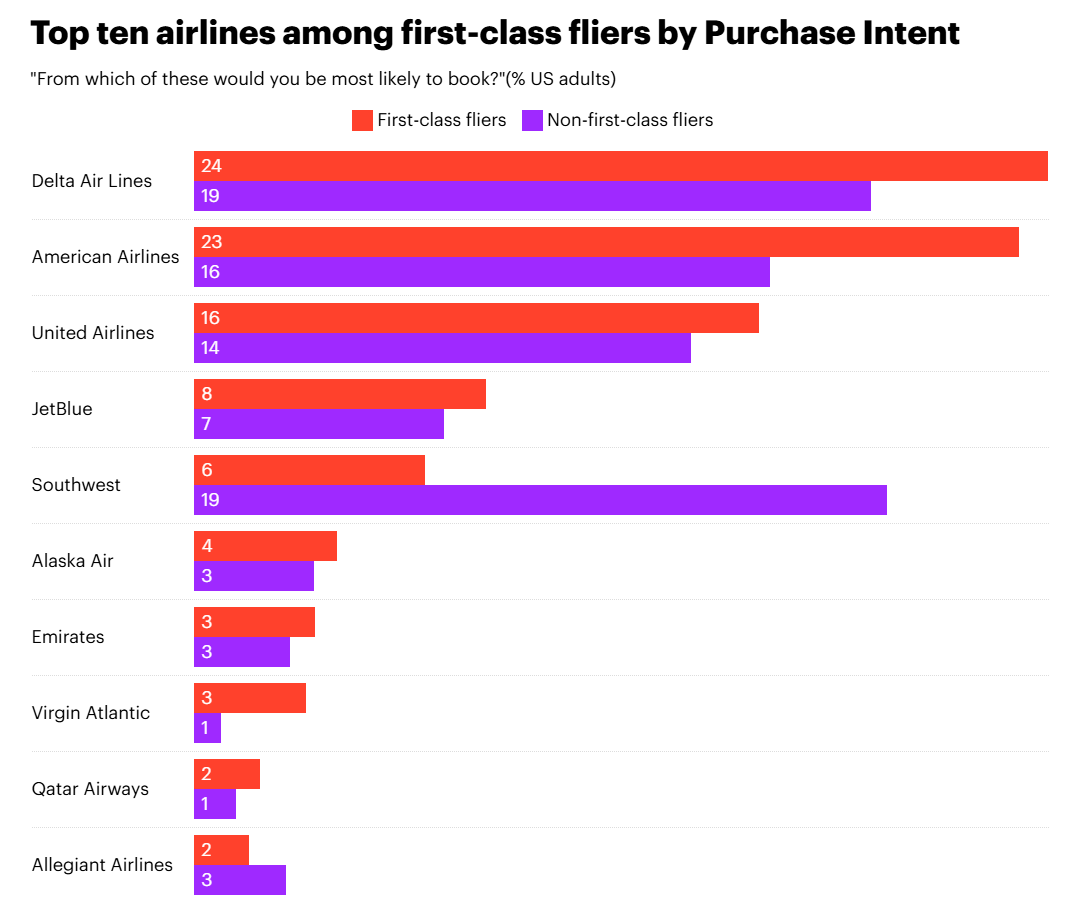When I was first traveling for work, the first class cabin was mostly upgrades. And that meant it was frequent business travelers, who skewed middle aged and male. Younger passengers seemed out of place, and women felt out of place, and since they didn’t seem like the usual type flight attendants would seem to treat them differently, too.
Things are different today. First class fares have come down a lot, there are plenty of upsells to leisure travelers, and as little as 13% of first class seats may be going to upgrades (Delta, but other airlines are catching up to them). The demographics of who is sitting up front have changed, but there are still remnants of the past.

According to a YouGov survey,
- First-class fliers are still more likely to be male and have higher incomes (≥200% of the median income).
- They skew somewhat more likely to be from the West, especially California, than Midwest or Northeast. They’re also more likely to be married with children (correlates with older and higher income, though also higher expense).
- Gay men also have a modest propensity to buy first class (twice as high as heterosexuals), but this does not hold for lesbian or bisexual passengers.
- Somewhat strangely, first class passengers are likely to identify as eco-conscious (which correlates with high income) and also greater than average likelihood of being climate-skeptical (they’re flying on planes! and taking up more space on planes!).
- More frequent travelers are more likely to buy first class, with 22% traveling four or more times per year versus 14% of other fliers. They plan trips somewhat further in advance, but are also more likely to use travel agents (21% vs. 9%) or book by phone (23% vs. 12%), which probably is a function of being an older, higher-income demographic.

First class flyers, defined as those buying a first class ticket at least once in the last year, are more motivated by temperature and activities at their destination than cost – not surprising since they’re less motivated by cost in choice of airfare. They do less sightseeing and outdoor activities then coach passenger (again, older).

They also prefer carriers that have first class, while avoiding ones that don’t. Strictly coach flyers tend to prefer Delta or Southwest. Presumably lack of preference for carriers like Alaska is a function of their limited reach (not an option for most) rather than a view of their relative product. The greatest preference is expressed for airlines who serve the greatest number of passengers.

Also unsurprisingly, first class flyers visit California and Hawaii, while Florida more of a coach destination.
(HT: Flyertalk blog)


Oh, Gary, these comments are surely to go ‘well’–it’s as if you blew a dog whistle.
Let me distill it down for you: higher income people fly first class. That’s the headline. Higher income people tend to be white and male, that checks out. California is highly populated and far away from everything, so that checks out. The airlines are finally realizing that there is a price point that makes 1st class an attractive option for a lot of people, high income white males who live in CA being the largest segment of that market. I know because I’m one of them.
… and Florida proves again its low rent.
@Darin —As Gary said so eloquently, “more of a coach destination.”
basic AF.
And then there are those of us who are high income couples (my wife is as high income as me) in CA who have family in FL, so we do fly there first class. But it’s the CA effect. 🙂
Cheers.
While this tracks with general expectations and anecdotal experience, I am confused by the survey itself. It seems the numbers in the charts are absolute respondents, not percentages. So this seems to be an extremely small sample size to definitively say this represents the entire United States population.
And there are a number of older couples, like us, who have basically outgrown the cramped conditions in coach. We will buy first class if the fare difference is reasonable. Premium economy on an overseas flight is also good as it is basically the same seating as domestic first class. The real goal is avoiding the third person, which is why economy seating on an Airbus A330 also works, with its 2-4-2 configuration.
This is unsurprising for the major cities on the coasts, where a more ‘premium’ experience is offered (aircraft with actual ‘lie-flat’; newer, more luxurious lounges), like MIA-LAX, SFO-JFK, etc. But let’s be honest, if you’re flying out of a smaller regional airport, like JAX, MCI, or BNA, it’s gonna be ‘recliner’ at best, likely on an aging 737, a321, E175, or CRJ9, so it’s not really ‘that’ much better up-front. As for demographics, yeah, that sounds about right, depending on the route, day of week, etc.
So why does there appear to be such a marked preference for AA and DL among first-class fliers? Product, network, price or….? Or is this survey worthless?
When you first started getting complimentary domestic upgrades because of airline elite status, the front cabin on the flights was mostly middle age European-American males.
Women, visible ethnic minorities and young adults were uncommon in the domestic first class cabin. Thanks to the great DEI engine that was America, the country boomed and the passenger mix changed in the front cabin.
@carletonm — I hear you. On the ‘2 seat’ economy configuration: other than Delta, most US carriers have given up on the a330 (American used to have many). As I’m sure you’ve noticed, with the newer aircraft, United and American have opted for more 787 with 3-3-3 in the back, and Delta is going with a350, a similar 3-3-3 configuration, all of which does not help with your ‘third person’ problem. Delta and United still have ample 767 with the 2-3-2 (American retired theirs). UA and AA’s 777 are a mix of 3-3-3 and 3-4-3, which is not great for this concern (other than a few ‘special’ 2-4-2 rows at the bulkhead and in the back). Plenty of European carriers still operate a330, though.
@GUWonder — Wow, a rare positive-use of the ‘DEI’ acronym (unless you were being sarcastic). Yes, diversity, equity, and inclusion is actually good for growth and economic prosperity for most people. Many women, non-white folks have ‘merit’ and are actually the best people for the job, regardless of their demographics. No doubt, those who disagree will ‘speak their minds,’ shortly.
What if airlines had a base charge for first class and various surcharges. Women have no surcharge. Men have a surcharge. If white, a surcharge. Black have no surcharge. Latino/Latina have a small surcharge. Lesbians no surcharge. Gay men have a surcharge.
@derek — How about ‘no.’
jason,
it comes down to network size. AA and DL have large domestic networks with first class cabins. UA is far behind because it spent so much time focusing on international markets and failed to develop its domestic network until the past couple years.
It is also noteworthy that DL is the largest US carrier by mainline seat miles which is related to the fact that DL has the lowest percentage of its network on regional jets – and DL also has all two cabin regional jets except for a few operational spares which carriers are allowed to “sub in”
and then you have the fact that DL has the highest amount of corporate traffic -significantly higher than AA and UA. while many people pay for first class travel out of their own pocket, there is a decent percent that is covered by companies esp. for higher-ups.
Delta curates its in-flight experiences for elite, discerning guests from the West Coast.
As a long time commentor- I think fairly too- and data guy, the sample size of these responses are statistically insignificant. Yes, 50 responses for the larger airlines are better than 10, or 5, but there is likely ridiculous survey bias going on in this survey as well. I.E., the only people who respond are people who read this blog, are frequent flyers, or other wise biased to provide results.
But this can be overcome! Get a higher sample size, and to have a 95% confidence interval, bac of the napkin calculations would suggest just another 500 responses.
As someone that avoids coach like an STD my experience:
1. Older couples. Often they seem to fly infrequently the way they go charging the line when preboards are brought up and seem to get lost in a 16-20 seat cabin
2. Males (and some females) that have well paying Teams/Zoom jobs that can be done from anywhere (like me) that want comfort. Most probably savvy enough to understand the cash upgrade system.
The days of gawking at that app hoping my name clears are over for me.
@Timbits: Delta is the airline by scum, for scum. I would never fly it unless a gun was put to my head or the drive at the end of my flight was more than two hours.
@George N Romey — Please keep your STD experiences to yourself!
(Sorry, couldn’t resist.)
What I want to know is how do they know your sexual preference when buying an F ticket? Or your color? Or your income level?
When I board a plane I always hope to see a broad range of ethnicities, and sees. Plus, I like to see kids in First, because I like kids more than adults, and because their presence in First passes off the adults.
I think one reason there’s fewer in the midwest may simply be because the flights are shorter. I’m already in the middle of the country, so the flight is like half the length; less time in a cramped seat (or enjoying a roomy seat), less time to enjoy in flight entertainment, and (given a decent part of the flight is the “no service” takeoff or landing portion) much less time to enjoy first class drinks, snacks, or meals.
@hwertz — Yup. Exactly what I was suggesting in my comment above. I’ve been on a lot of those 1-3 hour flights, where even if being up front is ‘nice,’ being in back is not ‘grueling.’ Whereas, if you’re on 16+ hour flight, you’d better believe ‘lie-flat’ is a major improvement over coach.
However, who can afford it often depends on who’s paying. Many corporate travel policies these days allow for first/business when the duration is 6+ hours, so you’d have to be going transatlantic or transpacific to get reimbursed for the premium cabin; otherwise, it’s book Economy, hope for upgrade, or pay out-of-pocket for it, if you really want it. Then there are savvy point redemptions, but those have really dried up for the super-cool stuff (like, Q-Suite is hard to find for just 70K AA points anymore).
It used to be different–in the past, companies were more generous to their traveling employees–but not as much these days, sadly. I suppose everything will be automated soon enough, and then I wonder, with that consumer base deteriorating, will there even be a sizeable market for air travel anymore–nah, then it’ll be just a few Greyhounds in the sky and mostly private jets.
Wow rich bros from LA, San Francisco and Seattle buy first class tickets the most. Who would have thought? I will say I have noticed a lot less sales guys yapping in my ear up there, now that upgrades are down. We really don’t care about the things you think you need to tell a whole plane about.
Very interesting results, thank you for sharing! Commentary in post and some of the comments largely make sense. To clarify some of the confusion, the data is presented in percentages, not absolute numbers (although sample size not given). Harder to make conclusions on some of the lower percentage comparisons without the sample size, would be curious to know what it was as well.
I think the definition of “first class flier” should be a little more nuanced. One year I took one first class flight while taking double-digit economy flights — I wouldn’t have considered myself a first-class flier that year.
Maybe we should have a similar poll of most frequent posters here and include the question: “Do you actually believe half the things you post or are you trolling?” 🙂
Awwww poor $30k/year OPM flyers sitting in Y because their corporate overlord only pays for economy.
But at least they have a spiffy elite tag on their oversized carryon and laptop bag full of exciting PowerPoints and spreadsheets of last quarter’s sales.
Women like men to pay for their higher class of service. When women pay for their own services, they tend to look at the cost and go with the more cost effective solution. Women are shorter and weigh less than men and so a coach seat is less uncomfortable for them.
Wealthy liberals especially wealthy gay liberals live a lifestyle that usually does not match their politics. The left is pro-gay agenda and so many who are gay adjust their beliefs to align with the pro-gay side.
@Wesley — No. I disagree with your attempt above at generalizing and stereotyping, which often leads to prejudice and harm against the groups you target. We know better.
The next genius insight from Leff the Logic Leader: Summer is hotter than Winter.
Curious if part of the reason the numbers are lopsided is because there are more first class seats heading east west than there are within the Midwest and Northeast sectors. Ie more widebody flights to the west and back mean more first class seats available for those markets. Meanwhile the East Coast and Midwest is dominated by shorter hauls making first class less valuable. Florida being the top coach destination kinda makes sense when you realize it probably has 2x as many flights there in the winter. Hell there’s even a direct flight from St Pete to TVC in the winter.
I find the fact that so many millennials are flying first interesting. I have hear complaints that they cannot afford a house but this shows that they aren’t afraid to spend the money they have on their own temporary comfort. To afford to buy a starter house, I saved up five years for the down payment and reduced my budget quite a bit to do it.
@jns — Well, the ones flying First probably can, but plenty don’t. Never mind…let’s go with your theory…everyone in a ‘generation’ is the same. Hold on, I’m nominating you for an International Prize in Statistics (it’s equivalent to Nobel).
I live in a somewhat aflluent area in So Cal – Palm Springs. It is next to impossible to get an upgrade out of here, at times you cannot even find an F seat to purchase.
Validates some of the data in Gary’s survey.
I fly 2-3 times a year Hawaii and Europe. I’m east coast and always go the overnight first class for the sleep pods and sometimes I will hoose the day time flight economy plus.
As a tall (6’6″) white Californian male, with large monetary resources, I model perfectly. 100% FC every flight. Never stepped my size 13 foot into a Southwurst que. Oh, I emphasize the height thing, as it is a proven corellary to higher income .
If I were to fly economy, it would be economy +. So each year I keep track of what I pay for my FC flights versus what E+ would cost. In the end, it’s worth it to me. And probably not worth it to some people who could buy and sell me. To each his own! As someone once said to me, might as well fly First Class because if you don’t, your kids will!
“Thanks to the great DEI engine that was America, the country boomed…”
Ugh! You’ve offered up this contention in the past, always absent any evidence to support it. Most likely, because there is none. DEI has little or no effect on a nation’s economy and mainly exists due to government force/encouragement and represents little more than empty virtue signaling. Now that the new administration is dismantling the existing narrative, businesses are quickly dropping their support. Finally, if DEI represented a boon to a company’s bottom line, they wouldn’t need to be forced into employing the rules or guidelines.
1990 is welcome to have some fun with Mike P.
Love DEIA. The civil rights movement and DEIA have been great for America and great for me.
This article is literally written about me, even down to the detail. I feel so seen.
I accept your surrender, GU. It’s obvious you’re incapable of proving your argument.
Unlike sex offenders Hegseth and his boss, I am no surrender monkey.
I also don’t spoon feed on demand, so Mike P can do his own research if he’s hungry for how the civil rights movement and DEIA has been a boon for the country and given the country’s economy a boom.
IB/Flyertalk appreciates the hat-tips, as they need more traffic — especially to low traffic forums on the site. VFTW links really help drive up the visitors there.
That response is even more embarrassing than the previous one. Your belief is that I have to do research to prove your point. Yep, that makes sense. Your comment does an excellent job of “proving” your ignorance.
Mike P needs to stop being lazy if he thinks that the civil rights movement and DEIA has been bad for America’s economic development and strength. [It’s certainly made the front of the flying bus more diverse than it used to be.]
A horse drinks best when it is thirsty and goes to the water itself. When a lazy donkey is full of The Party Kool-Aid and not thirsty for water, that’s on the donkey (and the provider of Party Kool-Aid).
Older white male in SoCal. I don’t think of Florida as a vacation spot. My friends that do are middle class at best and fly Southwest. All fly coach no matter what. They’ve never say in first class once. My wife and I fly to Caribbean Islands for vacations and do it first class. Trips that include JFK as a layover are great because out of LAX the first class is often business class international. Lie flat seats, wine and dine instead of domestic food. Plus JFK has a nice minute suites where we can get some shut-eye for two hours for just $40. Totally worth it!
@Mike P — Thought you would have been busy spewing hate over on Gary’s other post about ‘trans’ TSA officers. No, instead, you hide here, prematurely celebrating victory, yet again. Weak.
@GUWonder — Thanks for fighting the good fight, sir. Recall that Mike P often uses this silly ‘surrender’ line, like when he claimed to have ‘no opinion’ about Putin in Gary’s post about the Russians shooting down civilian aircraft from earlier in January this year. Mike P is either a foreign agent (a traitor) or a useful idiot.
Diversity is one of the greatest strengths of the United States. We are not a homogeneous people. We are a nation of immigrants, and proudly multiracial and multicultural. It is that ‘melting pot’ of different people from all over the world that makes us ‘great.’ No one, certainly not Mike P, can ever diminish that truth. No doubt, he’ll try, as others have in the past—wars were indeed fought and won over this very topic. Know this, the good, decent, open-minded people still out-number the hate-filled, bigoted, fearful losers like Mike P. My honest hope is his heart and mind is soon filled with joy, so he can actually appreciate all the good we have here, thanks to the ideals of diversity, equity, and inclusion. *holding my breath*
Oh, yeah, and guys, this is a post about which demographics fly First, according to some random statistically irrelevant survey. I’m going to assume Mike P sits in back.
@Mike Pee — Pardon me, sir. I want to clarify: you might like it ‘in the back,’ and there is nothing wrong with that, like, at all. Honestly, First is overrated these days. On most aircraft, it’s a difference between 2-2 vs. 3-3 seating. One could reasonably suspect that you prefer the company of others, so maybe a middle seat is more enjoyable. Again, we don’t kink-shame here, unless kink-shaming is your kink, then, once more, I really don’t know what to say—other than, ‘you do you.’
“Oh, Gary, these comments are surely to go ‘well’–it’s as if you blew a dog whistle.”
@1990. Your 12 comments suggest he just yanked on your leash to get you to come incessantly comment in what you seem to think makes you look woke but really is making you look homophobic and weird.
Tim, is this your new alter ego? The inability to control measure your own thoughts or responses sure is reminiscent.
@Julie — Lighten up. This is a roast.
And how dare you defame Mr. Dunn. He’s good man, who loves Delta very much. I’m a fan, too, but I also have my own opinions, which I share freely, because, this is still a free country, and we should all be grateful that Gary supports such freedoms on his site.
Well, now we’ve proven that neither GU or 1990 can support any argument that DEI has led to a significant increase in economic activity. Nope, they make the assertion and expect us to accept it blindly.
@Mike P — You mean to say that people of different ages, races, ethnicities, abilities, disabilities, genders, religions, cultures and sexual orientations, have not led to a significant increase in economic activity? Now we’ve proven Mike P is a fool and a loser. Now, that’s ‘common sense.’
Sorry, but we’re talking about DEI, you’re referring to a diversity of people. Nice use of nuance. Two completely different things. Thomas Sowell nails it in this article. My favorite line is, “But what justifies diversity? Nothing but unsupported assertions, repeated endlessly, piously and loudly.”
https://www.creators.com/read/thomas-sowell/12/16/the-diversity-fraud
(Warning: I don’t recommend anyone trust a link Mike P shares here. He’s a foreign agent trying to sow division.)
@Mike P — I accept your surrender (as you like to say). Diversity is no fraud. You provided the perfect example of an ‘Uncle Tom’ in Mr. Sowell—his first name is literally ‘Tom.’ (For those who don’t know already, Sowell had the audacity to suggest that the slaves should be grateful for slavery alleging they were better off here than in Africa. Reprehensible.) I suspect you’ll promote far-right propagandist and convicted felon D’Souza next. You can try to re-write history, but it doesn’t make it true or good. Decent people still outnumber those filled with hate. Rest assured, I’ll keep calling you out.
Not from my experience. Most FC seats are middle aged women. Married by the ring. And well kept. Almost flying call girls…
I mostly see married couples and the elderly in first class.
I only fly first the last 7 years. My demo is 44 yr old married male with 1 child. Live on Maui so all flights are 5hrs+. Top 1%+ income. Surf and snowboard for fun. I could give a crap less about service food and amenities kit. I simply want the comfiest seat on the plane. 6’2 225lbs. Would fly coach if it didn’t wreck my hips and QL after a 2 hrs. Look forward to trying the new 2×2 premium economy (or whatever it’s called) product
Also, most lay flat seats suck as can’t full straighten my legs and my feet are too big for the foot hole. I prefer the older recliner style seats.